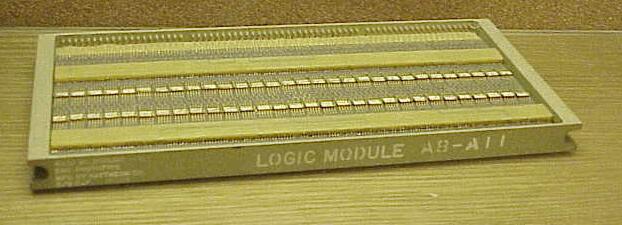 |
Apollo Guidance Computer and Logic Modules [no longer on display returned to CMHC] (1960) – Stanford.edu: This is the type of computer that went to the moon in the Apollo missions from 1969 to 1972. There was one computer in the Lunar Excursion Module (LEM) and one the mothership (CM) circling above. It was the first use of integrated circuits, as still displayed in the timeline cabinet to the left. It’s cycle time was 1 Mhz, 11 instructions. It had 1K of 16 bit words of erasable (RAM) core memory and 12K of read-only memory (ROM). The ROM held the “Colossus 249” flight control software. There were no disks or tapes in the flight system.















It is a testament to human ingenuity that we managed such a tremendous feat with so little.
Its also a shame. We have much better tech now, but what have we done with it lately?
Why doesn’t our reach exceed our grasp anymore?
The only reason we went to moon was to beat the Soviets. Once that was done nobody cared anymore. One of the great tragedies of our times.
Ok, thats it. Im starting the rumor that theres Pinko Commie Fascist Terrorists on Mars.
We’d better fight ’em there so we don’t have to fight em here.
They used CORE MEMORY???? WOW!!!
Hey, they just found out that the moon of Jupiter, Titan has more hydrocarbons that all of the Earth !!! So I expect that Mobil/Exxon wants it all, so expect to see NASA dump the moon and Mars and say we need to go to Titan instead !!! Got to keep those SUVs and Humvees gassed up !!! Even if it means we melt all the snow-packs and flood our coastal cities, thats “Progress” – for Mobil/Exxon anyway !!!
#5 You laugh, but that will probably be the only reason for large scale exploration of the solar system. Big business has the money and will to finance such projects. Science always takes a back seat to profit. No matter how we get there, we have to get there.
Neat to see. My Dad worked at NASA (actually, for Boeing) in the late 60’s – early 70’s on Apollo 8 through 13. I remember finding his slide rule when I was growing up and him telling me that’s how they did their calculations, blew my mind at the time and even more so now.
While this computer is a milestone, there is a greater achievement in computing of that era. The Litton Guidance L-304, first built in 1960, was the first *ALL* IC computer built. It had a whopping 1M BYTE of solid state RAM instead of core memory (costing a dollar a bit!), had a 32-bit data path, hardware multiply and divide, and implemented the first hardware square-root!
While the L-304’s hardware has been re-designed numerous times since 1960, it’s architecture has remained unchanged. Starting as a 400 lb. foot locker sized box, the L-304 is now in it’s 3rd generation of single chip silicon. In 2007 it was announced that the L-304 design would be retired in favor of an embedded PC running Linux.
#5, #6, Titan: amazing isn’t it? Bet it smells like a refinery. Here’s a good article:
http://tinyurl.com/yu8c44
I must be a geezer. I remember when my System/360 Model 40 received a 32K core mem update. It took 2 IBM CEs to install and was larger than a huge refrigerator. You could actually see the bits.
Anyone remember the precursor to ICs? It was called “thin film.”
Anyone knows if core memory was used for being more radiation resistant?
The use of core memory had more to do with the fact that it retains its 1’s and 0’s even after power to it has been removed. This would be important during transition from ground-based to space-craft power or perhaps during separation of LEM from command module. Flash memory has been similarly used in mil aircraft since the mid-80’s.
so did they do the video editing on this or was it just a prop on the set where they faked the moon landing?
j/k
It’s just a hunk of plastic, #12. The editing was done with a razor blade and tape.
There’s a story about the guy who had to call go/no go when this thing started throwing errors as Apollo 11 neared the surface. If he lets them go and it crashes, the entire history of NASA may have ended right about there. That man had brass ones.
#11 Miguel,
Yes core magnetic memory is much less susceptible to radiation than semiconductor memory. The Space Shuttle used core memory in its five main computers until the computers were upgraded in the early 90’s.
See: http://tinyurl.com/33luzg
http://tinyurl.com/yt42xn
Apon seeing the many rockets at the Cape in Florida, the static display of the Apollo lying sideways near the assembly shed at the cape was one of the most interesting.
Near the rocket engines for each module, there where black boxes built into the skin of the modules. These were the actual computers, as space was critical with the modules, they placed the computers in hard cases on the outside of the modules. Even for the moon lander.
So if the computer decided to shit itself there was no way it could be jumpstarted or fixed in any way.
Each module had it own computer which were all co ordinated to act independently of each other with no super computer to monitor the whole show so to speak.
Thank christ the os was not made by microsoft…
One computer on the LEM and one on the mothership?
How many backup devices?